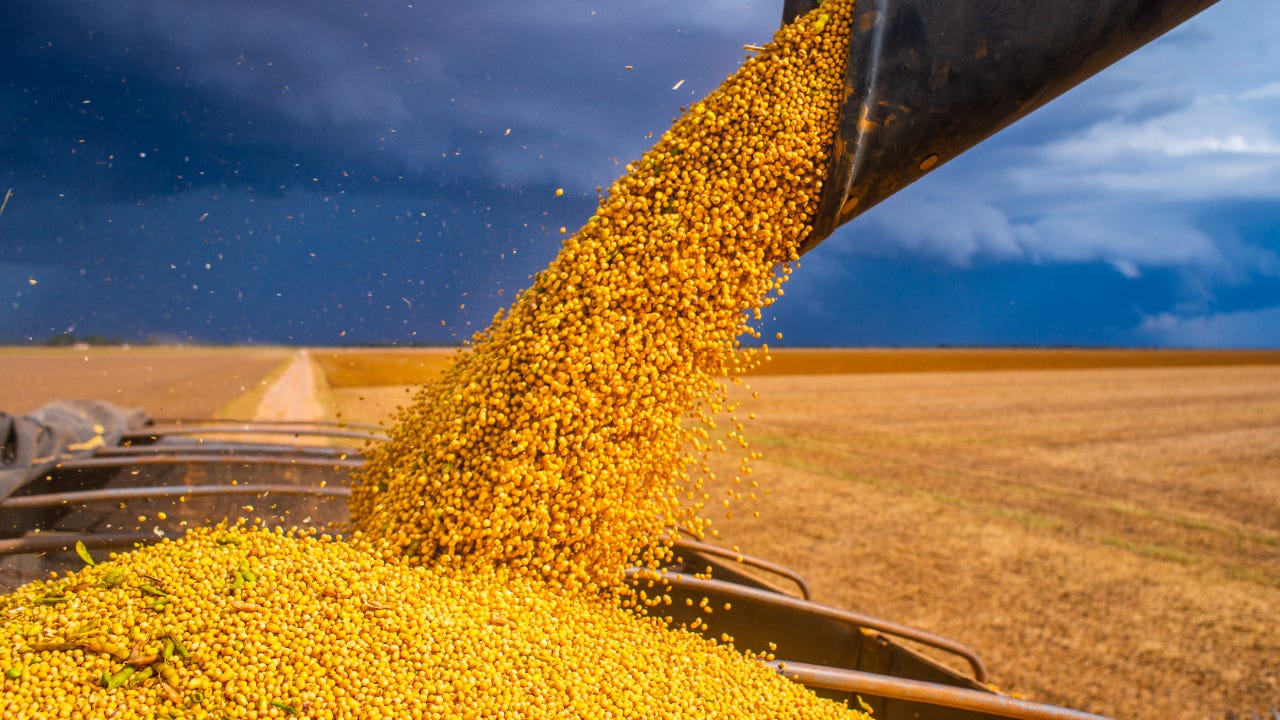How to invest in commodities

The Bankrate promise
At Bankrate we strive to help you make smarter financial decisions. While we adhere to strict , this post may contain references to products from our partners. Here's an explanation for .
Commodities are often overlooked as a component of an investment portfolio, with many financial advisors recommending only allocations of stocks and bonds (or funds holding those two asset classes). But some experts argue that investors need further diversification in their portfolios to help reduce risk and smoothen out returns.
And that’s where commodities investing comes in. Commodities, such as precious metals, oil, agricultural products and more, move based on their own highly specific industry conditions. That can make them attractive trades when you’re looking to diversify your portfolio.
Here’s what to consider if you’re wondering how to start investing in commodities, including several ways to invest in the space and a few things to watch out for along the way.
What is commodity investing?
There are several ways to invest in commodities, which are raw materials that are either used directly, such as food, or indirectly to produce another product. Oil is a commodity that’s used in the production of many different goods and services. Airlines spend an enormous amount of money on fuel for their planes and the price of oil can have a big impact on an airline’s profitability.
You can invest in commodities in several different ways including by purchasing physical goods, such as gold, or by purchasing ETFs that track specific commodity indexes. You can also buy stocks of commodity-related businesses such as oil and gas producers or miners of precious metals. Commodities can be quite volatile, so be sure to understand the risks you’re taking before making an investment.
You can also profit off commodities by using futures contracts, which is an agreement to buy or sell a commodity at a specific price and date. You can make a lot of money through futures contracts if you’re right about the underlying commodity price, but you can lose a lot too. Be sure to understand the risks involved so you can avoid, or at least be aware of, the potential for a margin call and other events that can impact the success of your trade.
Commodity investing: What to watch for
Investors may talk about commodities as if they’re one thing, but commodities consist of dozens of different products, and each operates according to its own specific supply and demand.
Popular commodities
Some of the most widely traded commodities include:
- Precious metals (gold, silver, platinum, etc.)
- Oil
- Natural gas
- Corn
- Wheat
- Soybeans
- Cattle
- Hogs
- Lumber
So when you’re looking at commodities to invest in, it’s important to focus on the specific factors that are driving each one. For example, if the futures price of gold is rising, it may be due to a host of differing supply and demand issues that have nothing to do with natural gas or hogs, for example.
Therefore, learning how to invest in commodities can be more complex than the catch-all term indicates.
Supply and demand rule
Commodity industries are all about supply and demand. In any individual commodity industry, the product is largely the same. Wheat is wheat, cattle are cattle. Because of this, producers are all price-takers and in normal times are not able to dictate prices. Many commodity industries are prime examples of what’s called perfectly competitive industries, with many buyers demanding an undifferentiated product and suppliers unable to offer differentiated products.
So what causes prices to fluctuate are imbalances in supply and demand, which may occur for many reasons. Prices may spike if demand rises or supply becomes constrained. One of the most notable cases was lumber prices, which soared in 2021 as supply had not fully come back online from being shut down as part of the broader COVID slowdown in the economy.
But if demand declines or supply comes back, prices may fall to prior levels or even move lower. That decline, too, is happening with lumber, as supply comes back and the situation normalizes.
Investing in commodities requires understanding the supply-demand situation, where it’s going and how fast it’s going to get there. Prices can rise and fall quickly, and often do not persist. As the old saying goes, “High prices are the cure for high prices.” That is, if suppliers can reap high prices by increasing production, they’ll do so, and eventually prices will drop to typical levels.
Lowest cost wins in commodities
Because companies are price-takers in commodity industries, the companies that win here are those that produce at the lowest cost. They generate the most profit per unit, and even if the price of the commodity declines, they’ll still be able to exist as long as the market is open.
In general, the most precarious companies are those that produce at high costs. If prices fall, they won’t be able to produce at a profit and they can’t eke out more because they’re price-takers. So they may eventually go bankrupt if the industry doesn’t turn around soon enough.
Of course, if you’re trading the price of the commodity itself, you may be ambivalent about any individual producer, though if supply goes offline, it could help push prices higher.
Price spikes are often short-lived
Over time prices of commodities will tend to move toward an equilibrium price that matches demand and supply. But in the short term, commodity prices are volatile and they will tend to overshoot this equilibrium price on both the upside and downside. So, markets often overcorrect as producers rush in to correct a lack of supply. But then they might stick around to recoup their investment and end up staying too long — pushing the commodity price below a sustainable level.
So price spikes and even massive declines are often short-lived. The spikes bring marginal suppliers online, while later declines shake out the marginal suppliers.
Risks of commodity investing
- Volatility – Commodity prices can be extremely volatile and leave your portfolio exposed to large price swings. The volatility can be an opportunity, but it’s also a major risk.
- Speculative – If you’re hoping to profit solely based on the price of a commodity, then you’re speculating, not investing. Your asset won’t produce any underlying cash flows, which means your profit is entirely dependent upon the price of the commodity.
- Geopolitical events – Commodities are uniquely exposed to geopolitical events around the world. For example, oil and natural gas prices spiked following Russia’s invasion of Ukraine in 2022.
- Weather – Commodity prices are also impacted by weather conditions around the globe. If bad weather impacts the growing conditions for a commodity, the supply may suffer, causing prices to spike.
- Concentration – Commodity investing often means that you have a large exposure to the price of a single asset such as oil or gold. There are ways to diversify your exposure somewhat, but you won’t be fully protected if the price of the commodity falls.
5 ways to invest in commodities
Investors and traders that are looking to plunk down money on commodities can choose to buy the products themselves, futures contracts, shares in the companies producing them and even ETFs.
1. Futures
Buying commodities through the futures market may be the best-known method to invest in them, even if it isn’t the easiest way to do it. Futures are a high-risk, high-reward way to speculate on a given commodity, and that’s what draws some hardcore traders to the space.
Futures allow you to put up relatively little money to open a contract, and you can use the power of leverage to quickly win (or lose) a fortune. As long as the trade goes your way, you won’t even have to put up more on the contract, making it a cost-efficient way to speculate.
Risks: Things are fine as long as the trade moves your way, but if the trade moves against you (below your maintenance margin), you’ll have to keep adding money to hold it open. So you can make a lot of money quickly – that’s the draw for traders – though you can lose it as quickly.
2. Physical commodities
It’s also possible to own the physical commodities directly, though some – hogs, cattle and oil come to mind – you probably won’t want to own directly. Instead, commodities such as precious metals are popular for those who want to actually own the metals and have a hedge against inflation.
You can purchase bullion in a number of ways, including through online dealers or pawn shops, or you can buy gold and silver coins for their bullion value. You’ll want to be careful that you’re getting close to the spot price on purchases and avoid paying up for collector’s value on coins.
Risks: The biggest risk of owning precious metals directly is that they could be stolen, so you’ll want to make sure anything substantial is fully protected. Your investment can also be dinged if you need to sell in a hurry, especially to a dealer. It can be hard to get the full market value of your bullion or coins, so you may have to settle for what you can get right at the moment.
3. ETFs of physical commodities
If you want direct exposure to physical commodities without the hassle of actually owning the goods or trading on the futures market, you have the option of investing in them through ETFs.
ETFs provide a convenient way to take a position in a commodity or a group of them.
For example, you could buy an ETF that owns gold, oil or even a combination of commodities. So you may be able to get “pure play” exposure to a commodity along with the simplicity of an ETF.
The big benefit here is that you get direct exposure to the commodity and market-based pricing, so you’re likely to get the best price for your holdings when it comes time to sell them.
And these ETFs allow you to dodge the biggest risk of owning physical commodities, the danger of theft, as well as potentially the cost of storing them, depending on the commodity.
Risks: ETFs give you exposure to the commodities prices, which can be very volatile, even more so than stock prices. And since the commodity itself doesn’t generate cash flow, your optimal return is the return on the commodity minus the price of the fund itself.
4. Stock of commodities producers
If you don’t want to own physical commodities (perhaps because they don’t inherently produce cash flow), you can opt for producers of commodities and still be in a position to win when commodities prices rise.
Stockholders can benefit in two ways with producers. First, if the price of the commodity rises, the underlying company usually sees its profit rise. Second, the company can increase production over time to increase profit. So you have two ways to make commodities work for you.
Risks: Commodity producers are often risky investments. Commodities industries are subject to boom and bust cycles, and companies require a lot of capital. Buying individual stocks requires a lot of work and analysis, and investing in a few stocks is riskier than buying a diversified group of stocks. So if you go this route, you’ll want to carefully understand the company and industry.
5. ETFs of commodities producers
One way to gain diversified exposure to commodities producers is to buy an ETF that owns a portfolio of them. You’ll gain the benefits of diversification and may be able to gain focused exposure to producers of a specific commodity. For example, you could buy a gold miner ETF, and enjoy the benefits of cash-flowing producers and bet on the rising price of gold, too.
Risks: If your ETF is focused on a specific commodity, such as oil producers, you’re diversified, but narrowly. That is, you’re not overexposed to any single company, but if the price of oil falls, this kind of diversification won’t protect you as much as broad diversification would. But that’s the flip side of trying to gain “pure play” exposure to producers of a specific commodity.
Why commodities are a popular investment
If commodities don’t produce cash flow and price spikes are often short-lived, what exactly do investors and traders find interesting about them? Here are some of the biggest reasons why they’re so popular:
- Inflation protection. Commodities can offer inflation protection to your portfolio, as the prices of such “hard assets” may rise over time as inflation does.
- Low correlation to other assets. Prices of commodities often move around for much different reasons than the broader economy and depend on factors specific to each commodity. Therefore, their performance is less correlated with stocks and bonds. Because commodities are less correlated with other asset classes, they can be used as a way to diversify a portfolio, reducing risk and smoothing returns.
- Hedge against other investments. Owning a commodity can reduce risks in your other investments. For example, if you own a company such as an airline that may be heavily exposed to the price of oil and would decline if oil rose, you can own oil directly and help offset that portfolio risk.
Bottom line
Investing in commodities can add some diversification to your portfolio, though many – maybe most – portfolios can safely do so without the extra exposure if they’re already broadly diversified. Still, if you want to learn how to buy commodities , you have many ways to get in the game, but make sure you understand the risks and rewards of each approach. And remember that spikes in prices are often short-lived, so commodities may not be great buy-and-hold investments.
Editorial Disclaimer: All investors are advised to conduct their own independent research into investment strategies before making an investment decision. In addition, investors are advised that past investment product performance is no guarantee of future price appreciation.
Related Articles



